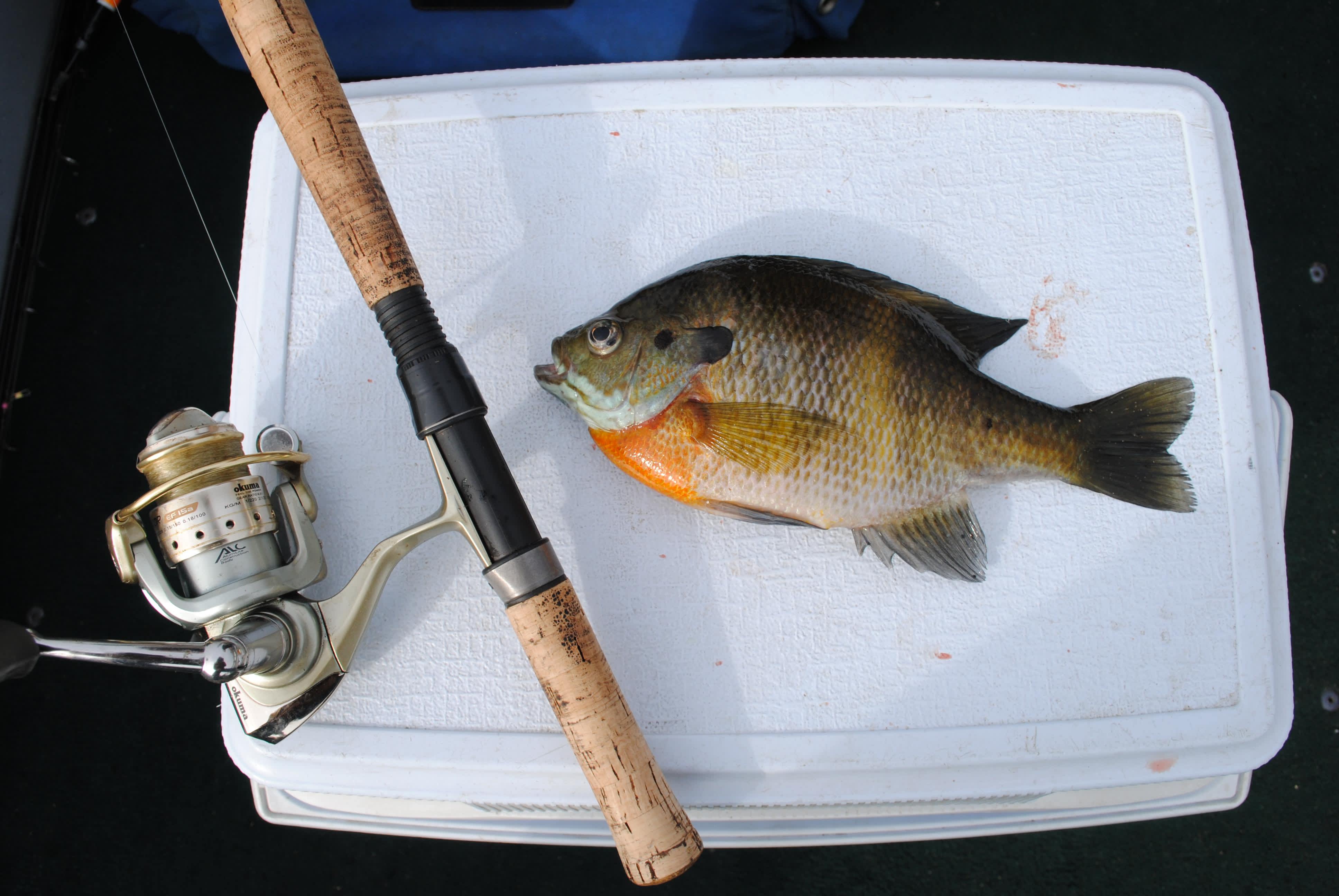Staying in the Shallows for Michigan Bluegill
Bob Gwizdz 05.20.13

For most of the last decade, I’ve been fishing for bluegills a day or two a year with Denny Hettig, who has developed a simple trolling approach that is not only incredibly productive, but also almost idiotproof. So imagine my surprise when we pushed off the bank on small Van Buren County lake recently and Hettig handed me a rod rigged with a bobber.
Hettig not trolling?
“We’re fishing skinny water,” Hettig said. “A foot to two feet. Weedy. It’s tough fishing and tough on your gear. You’ll learn all kinds of new words. But they’re there.”
Hettig maneuvered us away from the ramp with the trolling motor, about a good cast-and-a-quarter away from the bank. We threaded about a half of a red worm on a fine-wire No. 8 hook that was maybe a foot below a weighted bobber–with no split shot on the line–and heaved the rigs, hard as we could, toward the bank.
The pencil-style bobber laid flat on the surface. When I saw it begin to stand up, I set the hook. Ta-da. It was about an eight-inch bluegill that twice wrapped me up in submerged vegetation before I finessed it out of there.

“Well, that’s not really what I wanted to show you,” Hettig said. “There’s a lot them in here bigger than that. But that’s how it’s done.”
We moved slowly, maintaining as much distance as we could from the bank but still reach it. And we caught fish at a pretty steady clip.
Hettig usually trolls for bluegills spring, summer, and fall, but there’s no way we could get at them trolling in that skinny, weedy water. Typically, Hettig said, the bluegills can be found ultra shallow from just after ice-out for a few weeks, but this year, the water stayed cold longer than usual. Once the water warms a bit–and the ‘gills move back out off the bank–it’ll be trolling time again.
We caught enough for a good fry within an hour. We were tossing back the bigger ones (up to about nine-and-a-half inches) and keeping fish in the seven- or eight-inch range. That’s Hettig’s style; not only do the smaller specimens eat better, he said, but the big ones obviously have the right genetic stuff. So he lets the big ones go to reproduce.
Along those same lines, Hettig also prefers to keep females and let obvious males go, which is kind of contrary to most folks’ thinking. “A female produces, what, 20,000 eggs?” he asked. “You don’t need that many females to keep the population going. It’s the males that guard the nests.”
Watching the other anglers on the lake, we were clearly out-fishing them. Attention to detail was why, Hettig said.
For instance, Hettig uses four-pound test line because even six-pound is too heavy, he said. And the lack of weight on the line allowed the fish to inhale the bait easily with no resistance. The weighted bobbers gave us enough weight to be able to cast a long way, which is extremely important when fishing skinny water, Hettig added. He replaces the spring on the bobber’s descender with a piece or surgical rubber tubing (so you don’t nick the line). He’s even particular about how he hooks on his worms: hook it near the nose, twist it around the shaft, hook it again, etc., threading it up the shaft, until it covers the hook eye, then he cuts the tail off.

Once, when I broke off, Hettig insisted he retie my line to make sure I did it correctly. He took the long-shank Aberdeen hook and, with his pliers, bent the eye back from the shaft at about a 45-degree angle and opened up the bend. Then he tied the hook on with a snell knot. The result, he said, is that when you set the hook, you get a good straight pull on it, which you wouldn’t if the eye was flat to the hook shank and you tied directly to the eye.
We fooled around for a couple of hours catching bluegills, pumpkinseeds and a few (nice) crappies. Experimenting with bait (we used both red worms and spikes) and using some flies, too, we caught fish on everything we tried (though we caught more runts on the spikes than we did on the red worms). As the sun rose we fished a little deeper–say two to three feet of water–but always on an un-weighted line that was long enough to hold the bait on or near bottom. That was one of the keys, Hettig said. The fish were feeding along the bottom.
We put a pretty good mess of fish in the livewell–Hettig said he only likes to keep 10 to 15, enough to have for dinner and fish sandwiches the next day–then continued to catch and release fish. As we moved around the lake, we found the fish were always in the same relative place: shallow with weeds.
Hettig said he was disappointed we never got on the big bluegills. “I had one that was an honest 11 inches the other day,” he said. But, heck, we would have just let them go anyway. And he invited me to come back, in the next couple of weeks, so we could troll for them.
Frankly, I can hardly wait.
For more information on Michigan fishing go to michigan.org. Click here to purchase a Michigan fishing license online.

